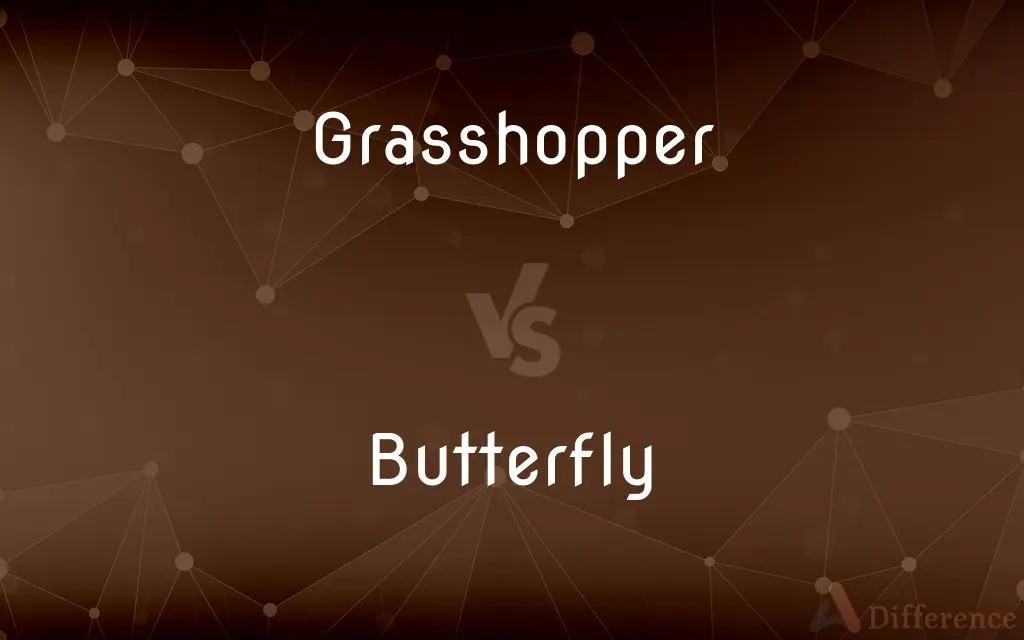Grasshopper vs. Butterfly — What's the Difference?
By Urooj Arif & Maham Liaqat — Updated on March 29, 2024
Grasshoppers are herbivorous insects known for their powerful hind legs for jumping, while butterflies are known for their colorful wings and role in pollination.

Difference Between Grasshopper and Butterfly
Table of Contents
ADVERTISEMENT
Key Differences
Grasshoppers belong to the order Orthoptera and are primarily recognized for their long hind legs, which allow them to leap great distances as a means of locomotion and escape from predators. Their diet consists mostly of grasses and leaves, making them herbivorous. On the other hand, butterflies, belonging to the order Lepidoptera, are celebrated for their vividly colored wings and their role in pollination.
The habitat of grasshoppers usually includes grassy fields, meadows, and forests, where they can find ample food and camouflage against predators. They are found worldwide, adapting to various environments but are most common in tropical and temperate regions. Butterflies, in contrast, are also found worldwide and inhabit a variety of environments, including gardens, meadows, forests, and even arid deserts. Their presence in an area is often indicative of a healthy ecosystem due to their sensitivity to environmental changes and their role as pollinators.
In terms of ecological impact, grasshoppers can sometimes be considered pests, especially in agricultural settings where large populations can cause significant damage to crops. Their feeding habits can lead to economic losses in farming communities. Butterflies, however, are mostly viewed positively for their ecological role. As pollinators, they are essential for the reproduction of many flowering plants, contributing to biodiversity and the production of fruits and seeds. Some butterfly species are also used as indicators of environmental health and biodiversity.
Behaviorally, grasshoppers are known for their ability to produce sounds by stridulation (rubbing their legs against their wings) or by snapping their wings while flying, which is mainly used for communication and to attract mates. Butterflies, while not capable of producing sounds, communicate through chemical signals and visual cues, using their colorful wings for mating displays and territorial claims.
Despite their differences, both grasshoppers and butterflies have significant roles in their ecosystems. Grasshoppers serve as a food source for a variety of animals, and their population levels can significantly affect local food chains. Butterflies, with their pollination activities, help in the growth and spread of plants, which benefits a wide range of animal species, including humans.
ADVERTISEMENT
Comparison Chart
Order
Orthoptera
Lepidoptera
Diet
Herbivorous, primarily grasses and leaves
Various, mostly nectar from flowers
Metamorphosis
Incomplete (egg, nymph, adult)
Complete (egg, larva, pupa, adult)
Habitat
Grassy fields, meadows, forests
Gardens, meadows, forests, deserts
Ecological Role
Can be pests, food source for other species
Pollinators, indicators of ecosystem health
Compare with Definitions
Grasshopper
Undergoes incomplete metamorphosis.
The nymph gradually develops into an adult grasshopper.
Butterfly
Recognized for colorful wings.
The butterfly's wings shimmered in the sunlight.
Grasshopper
Known for powerful hind legs for jumping.
The grasshopper leaped away as we approached.
Butterfly
Undergoes complete metamorphosis.
From a caterpillar to a beautiful butterfly, the transformation is complete.
Grasshopper
Can be agricultural pests.
A swarm of grasshoppers can devastate crops.
Butterfly
Essential for pollination.
The butterfly flitted from flower to flower, spreading pollen.
Grasshopper
Produces sounds for communication.
Grasshoppers stridulate to attract mates.
Butterfly
Communicates through visual and chemical signals.
Butterflies use their wings for mating displays.
Grasshopper
Herbivorous diet.
Grasshoppers feed on a variety of grasses and leaves.
Butterfly
Feeds on nectar.
The butterfly sipped nectar from the blooming flowers.
Grasshopper
Grasshoppers are a group of insects belonging to the suborder Caelifera. They are among what is probably the most ancient living group of chewing herbivorous insects, dating back to the early Triassic around 250 million years ago.
Butterfly
A nectar-feeding insect with two pairs of large, typically brightly coloured wings that are covered with microscopic scales. Butterflies are distinguished from moths by having clubbed or dilated antennae, holding their wings erect when at rest, and being active by day.
Grasshopper
Any of numerous orthopteran insects, chiefly of the suborder Caelifera, characteristically having long, powerful hind legs adapted for jumping.
Butterfly
A stroke in swimming in which both arms are raised out of the water and lifted forwards together.
Grasshopper
A light, usually unarmed airplane used for liaison and scouting.
Butterfly
Split (a piece of meat or fish) almost in two and spread it out flat
Butterfly the shrimp using a small sharp knife
Grasshopper
A cocktail consisting of crème de menthe, crème de cacao, and cream.
Butterfly
Any of numerous insects of the order Lepidoptera, having four broad, usually colorful wings, and generally distinguished from the moths by having a slender body and knobbed antennae and being active during the day.
Grasshopper
A mostly herbivorous insect of the order Orthoptera, noted for its ability to jump long distances and for the habit of some species communicating by stridulation; they are related to but distinct from crickets.
Butterfly
A person interested principally in frivolous pleasure
A social butterfly.
Grasshopper
In the strict sense, refers to insects in the suborder Caelifera, particularly those in the family Acrididae.
Butterfly
A swimming stroke in which a swimmer lying face down draws both arms upward out of the water, thrusts them forward, and draws them back under the water in an hourglass design while performing a dolphin kick.
Grasshopper
In a looser sense, also includes the katydids (also known as longhorned grasshoppers or bush crickets), which are members of the family Tettigoniidae, of the suborder Ensifera.
Butterfly
A race or a leg of a race in which this stroke is swum.
Grasshopper
A cocktail made with crème de menthe and optionally with crème de cacao.
Butterfly
Butterflies A feeling of unease or mild nausea caused especially by fearful anticipation.
Grasshopper
(figuratively) A young student in initial stages of training who has been chosen on account of their obvious talent.
Butterfly
To cut and spread open and flat, as shrimp.
Grasshopper
(musical instrument) In ordinary square or upright pianos of London make, the escapement lever or jack, so made that it can be taken out and replaced with the key.
Butterfly
A flying insect of the order Lepidoptera, distinguished from moths by their diurnal activity and generally brighter colouring.
Grasshopper
Any jumping, orthopterous insect, of the families Acrididæ and Locustidæ, having large hind legs adapted for leaping, and chewing mouth parts. The species and genera are very numerous and some are very destructive to crops. The former family includes the Western grasshopper or locust (Caloptenus spretus), noted for the great extent of its ravages in the region beyond the Mississippi. In the Eastern United States the red-legged (Caloptenus femurrubrum and C. atlanis) are closely related species, but their ravages are less important. They are closely related to the migratory locusts of the Old World. See Locust.
Butterfly
A use of surgical tape, cut into thin strips and placed across an open wound to hold it closed.
Butterfly tape; butterfly bandage; butterfly strips
Grasshopper
In ordinary square or upright pianos of London make, the escapement lever or jack, so made that it can be taken out and replaced with the key; - called also the hopper.
Butterfly
(swimming) The butterfly stroke.
Grasshopper
An antipersonnel mine that jumps from the ground to body height when activated, and explodes, hurling metal fragments over a wide area.
Butterfly
Any of several plane curves that look like a butterfly; see Butterfly curve (transcendental) and Butterfly curve (algebraic). Category:en:Curves
Grasshopper
A mixed alcoholic beverage containing crème de menthe, light cream, and sometimes crème de cacao. The name comes from its light green color.
Butterfly
(in plural) A sensation of excited anxiety felt in the stomach.
I get terrible butterflies before an exam.
Grasshopper
Terrestrial plant-eating insect with hind legs adapted for leaping
Butterfly
Someone seen as being unserious and (originally) dressed gaudily; someone flighty and unreliable.
Grasshopper
A cocktail made of creme de menthe and cream (sometimes with creme de cacao)
Butterfly
(finance) A combination of four options of the same type at three strike prices giving limited profit and limited risk.
Butterfly
(alternate history) A random change in an aspect of the timeline seemingly unrelated to the primary point of divergence, resulting from the butterfly effect.
One potential butterfly could be JFK having another son the year after the POD instead of a daughter.
Butterfly
(sports) A type of stretch in which one sits on the ground with the legs folded into a shape like that of a butterfly's wings, slightly rocking them up and down, resembling the wings fluttering.
Butterfly
A person who changes partners frequently.
Butterfly
(transitive) To cut (food) almost entirely in half and spread the halves apart, in a shape suggesting the wings of a butterfly.
Butterflied shrimp
Butterfly the chicken before you grill it.
Butterfly
(transitive) To cut strips of surgical tape or plasters into thin strips, and place across (a gaping wound) to close it.
Butterfly
To cause events after the point of divergence to not happen as they did in real history, and people conceived after the point of divergence to not exist in recognizable form, due to the random variations introduced by the butterfly effect.
Pearl Harbor not happening would've butterflied Taylor Swift.
Butterfly
A general name for the numerous species of diurnal Lepidoptera.
Butterfly
Diurnal insect typically having a slender body with knobbed antennae and broad colorful wings
Butterfly
A swimming stroke in which the arms are thrown forward together out of the water while the feet kick up and down
Butterfly
Flutter like a butterfly
Butterfly
Cut and spread open, as in preparation for cooking;
Butterflied shrimp
Butterfly
Talk or behave amorously, without serious intentions;
The guys always try to chat up the new secretaries
My husband never flirts with other women
Common Curiosities
What distinguishes grasshoppers from butterflies?
Grasshoppers are known for jumping and are herbivorous, while butterflies are known for their colorful wings and role in pollination.
Do grasshoppers and butterflies undergo the same type of metamorphosis?
No, grasshoppers undergo incomplete metamorphosis, while butterflies undergo complete metamorphosis.
Are grasshoppers considered beneficial or harmful to the environment?
Grasshoppers can be both, as they serve as food for other species but can also be pests in agricultural settings.
How do butterflies communicate?
Through chemical signals and visual cues, including their wing patterns and colors.
Why are butterflies important for ecosystems?
Butterflies are crucial pollinators and serve as indicators of environmental health and biodiversity.
What do butterflies feed on?
Butterflies mostly feed on nectar from flowers, which aids in pollination.
Do all grasshoppers have the same diet?
Most grasshoppers are herbivorous, feeding on a variety of grasses and leaves, but diet specifics can vary among species.
Can both grasshoppers and butterflies be found in the same habitats?
While both can share similar environments like meadows and forests, they each have specific habitat preferences based on their dietary needs and lifecycle.
How do grasshoppers produce sounds?
Grasshoppers produce sounds by stridulation or snapping their wings during flight for communication.
What role do grasshoppers play in the food chain?
They are a significant food source for various animals, influencing local food chains.
Are butterflies active at night?
Most butterflies are diurnal, active during the day, but some moth species (also part of the Lepidoptera order) are nocturnal.
Can butterflies affect crop production?
Yes, by pollinating plants, they can indirectly influence crop production and biodiversity.
What are the conservation statuses of grasshoppers and butterflies?
Conservation statuses vary widely among species, with some butterflies and grasshoppers facing threats from habitat loss and environmental changes.
How do butterflies contribute to the economy?
Through pollination, butterflies support agriculture and horticulture, crucial for food crops and ornamental plants.
How can people help protect butterflies and grasshoppers?
By maintaining natural habitats, planting native plants, reducing pesticide use, and supporting conservation efforts.
Share Your Discovery

Previous Comparison
Interviewee vs. Respondent
Next Comparison
Klondike vs. SolitaireAuthor Spotlight
Written by
Urooj ArifUrooj is a skilled content writer at Ask Difference, known for her exceptional ability to simplify complex topics into engaging and informative content. With a passion for research and a flair for clear, concise writing, she consistently delivers articles that resonate with our diverse audience.
Co-written by
Maham Liaqat













































